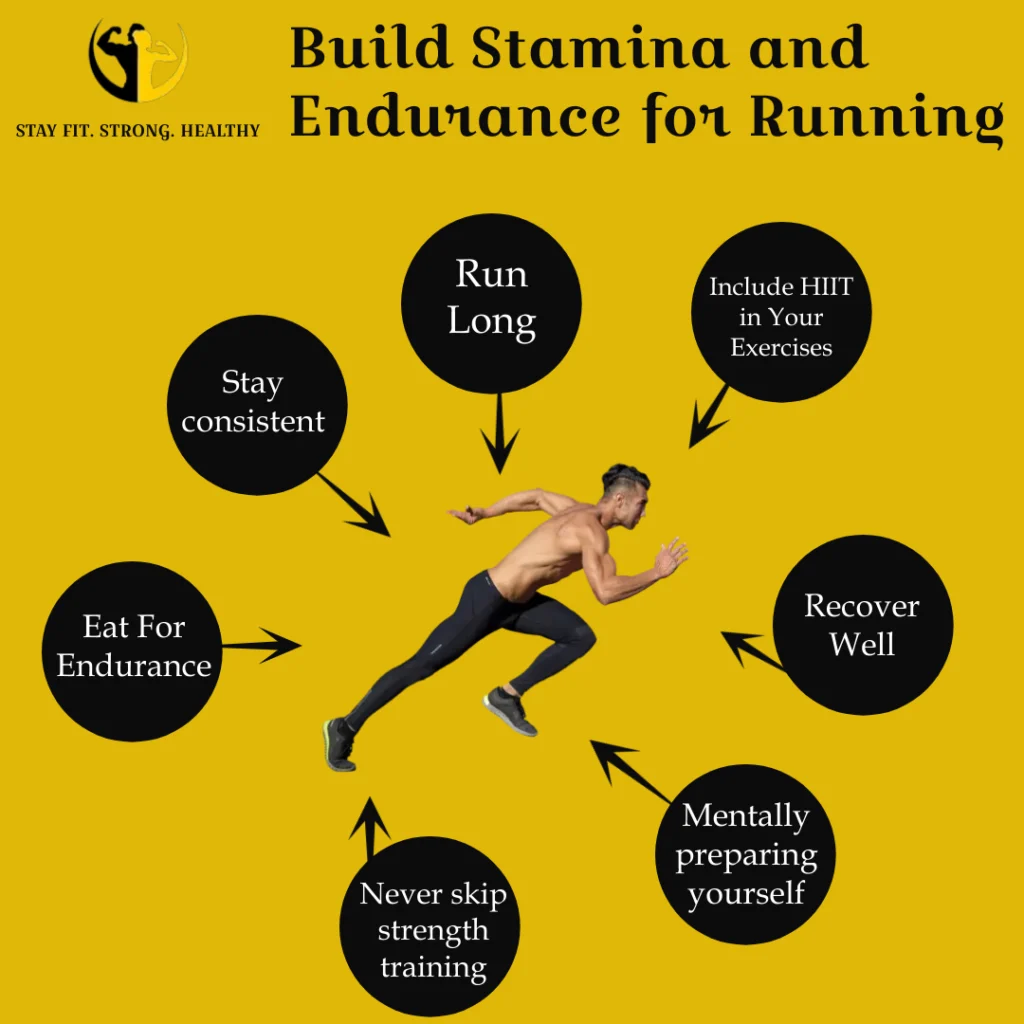

How to Build Stamina and Endurance for Running 7 Tips: Increase your stamina and endurance to run longer. Here’s how to modify your workout program so that it will help you last longer.


Consistency is key to building running endurance, therefore to build fitness, run multiple times each week for several weeks. There are no shortcuts to improving your running endurance.
A distance you found difficult one day will eventually seem more achievable. When that happens, it signifies your running endurance has improved.
Excellent stamina and endurance are important traits for runners. Anyone who works on their stamina and endurance will be able to run farther without becoming tired. Their minds and bodies have been trained to disregard the voice inside of them calling to them to stop. As a result, they’re able to keep running.
Running involves sustained, repetitive motion over a long period. If you lack the necessary stamina or endurance, you’ll tire quickly and stop. However, changing your exercise schedule will help you increase your stamina and endurance.
How to Build Stamina and Endurance for Running: 7 Tips
Stay consistent
By running as frequently as you can, you increase your endurance. Maintain a regular routine and go running at least three to four times every week. Your degree of fitness and running experience will determine how many runs you should do.
Beginner runners should start out slow and stick to just one or two runs each week so that their bodies can adjust. The running frequency can be increased for more experienced athletes. But keep in mind that recovery is important! Here are some suggestions for you if you have problems sustaining consistency:
- Set an alarm: An alarm might serve as a reminder to start your workout. Set an alarm to serve as a reminder of your goals before slipping on your running shoes after you get home from work.
- Find a running partner: Exercise commitment can be increased by running with friends. It’s great that you are integrating social time with exercise time.
- Set a time in advance: Running time may be neglected due to a hectic schedule. Make a running schedule in advance to hold yourself responsible.


Run Long
You must practice running farther in order to depends run farther. You can add five or ten minutes to your long run. Otherwise, you can extend your current long run by 0.8 to 1.6 kilometers. Although it might not seem like much, it starts to add up.
When you start to train more intensely for a half marathon or marathon, your long run should account for around 30 to 50 percent of your weekly mileage. Run your long distance at a slow, manageable speed (many people try to run their long run too fast and struggle to finish). Just concentrate on covering the distance as you move slowly. Remember that speed follows endurance.
Boost how to Build Stamina & endurance while running using this algorithm
- To start, figure out how far you intend to run each day this week. After that, type it here:
- [Total distance] x.30 = [Single Long run distance run]
- Once you can run this distance without suffering, multiply your total miles by .40, then by .50.


Include HIIT in Your Exercises
One of the best ways for how to Build Stamina & endurance is through high-intensity interval training (HIIT). In a study published in PLoS One in September 2013, it was discovered that interval training enhanced VO2 max (a measure of endurance) more than endurance training.
In interval training, periods of maximal effort activity are interspersed with rest periods. This may be a hill workout where you run up for 30 seconds and then stroll back down for 60 seconds.
Your heart and lungs become stronger through this form of interval training, preparing them for the demands of longer races. High-intensity training will also improve your muscles’ ability to deal with lactic acid, a chemical consequence of anaerobic respiration. During vigorous activity, lactic acid can accumulate in the muscles and cause a painful burning feeling.
Eat For Endurance
Getting enough protein, lipids, and carbohydrates is necessary. Here are some useful tips:
The best time to carbo-load before a run is in the morning. If running is your main form of exercise, you might obtain 50 to 65 percent of your macronutrients from carbohydrates.
The diets of runners must include fats. Cells and nerve function depend on them. Organs are insulated and shielded by fat. Moreover, during an endurance run, the body uses lipids as fuel when its glycogen reserves run low. Fat consumption becomes even more important if you tend to perspire a lot while running or experience chills because of perspiration because having adequate fats in your system might avoid exercise-related hypothermia.
How can stamina be improved? Boost your protein intake! After a run, eating protein helps heal muscle damage and preserve muscular mass.
You should refuel during a run if it will last more than an hour. Fueling during a race can be challenging because many athletes have intestinal problems. According to studies, simple drinks, gels, and bars that are high in carbohydrates are effective.
Recover Well
Longer recoveries are needed because of longer runs. There are a few methods you may use to make sure you are recovering effectively in between sessions.
How to Build Stamina & endurance for that you will get enough sleep. Sleep is essential for healing. While light exercise can promote sleep, heavy training can have the opposite effect. On days when you want to run a considerable distance, increase your usual bedtime by at least 30 minutes.
After a run, be sure to hydrate well. In other words, drink 150 percent more water because while running a person lost water through perspiration. The body can retain fluids when you consume something with a high salt level, such as a sports drink.
Receive a massage! While massage has been shown to be effective in treating DOMS.
Longer recoveries are needed because of longer runs. There are a few methods you may use to make sure you are recovering effectively in between sessions.
How to Build Stamina & endurance for that you will get enough sleep. Sleep is essential for healing. While light exercise can promote sleep, heavy training can have the opposite effect. On days when you want to run a considerable distance, increase your usual bedtime by at least 30 minutes.
After a run, be sure to hydrate well. In other words, drink 150 percent more water because while running a person lost water through perspiration. The body can retain fluids when you consume something with a high salt level, such as a sports drink.
Receive a massage! While massage has been shown to be effective in treating DOMS.
Mentally preparing yourself
Running longer than you’ve ever run can be daunting. It is possible for you to succeed!
It will be simpler if you mentally prepare yourself for your longest run of the week. Consider your run in portions rather than worrying about how to increase your stamina for long runs. Concentrate on completing one mile, one 5k, or one marathon at a time. As soon as you reach your first objective, do a mental evaluation of your physical and emotional health. Can you complete one more mile, one more 5k, or one more marathon? Go if the answer is “yes”! After all, running a slow 3k on top of a 10k already sounds less terrifying than doing a 13k.
Never skip strength training
Whether you’re a newbie or an experienced runner, strength training should be a part of your training schedule. Your running economy will increase, allowing you to maintain your speed for longer while using less oxygen.
Moreover, it can aid in the development of joint and muscular strength, making it easier for you to contract important muscle groups. The more effectively muscles are recruited, the more effectively one can move. According to the National Strength and Conditioning Association, this results in better running.
Here are some exercises for strength training you can do:
- Squats
- Deadlifts
- Over Head press
- Lunges
Why Endurance and Stamina Are Important in Running (Conclusion)
Running requires endurance and stamina so that you may run for extended periods of time without becoming exhausted. That doesn’t imply that finishing a marathon will be simple overnight. However, distances that were once difficult will eventually become comfortable. You will be able to run continuously while keeping your heart rate down during your workout.
You can accelerate your pace once you’ve mastered endurance. As your cardiorespiratory system becomes more capable of handling the demands of the task, your 5K race speed may transition into your training pace. You become mentally tougher and can push your body harder because of repeated exercise.
